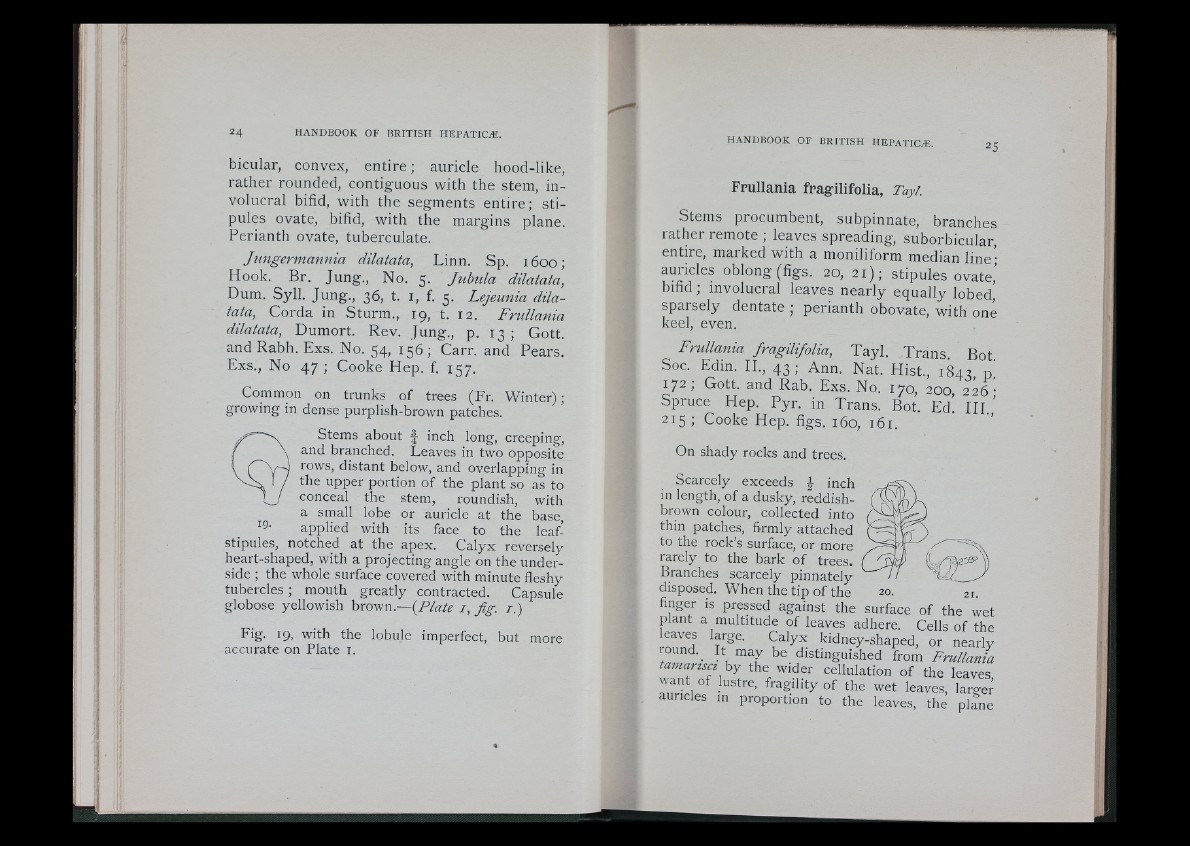
1
bicular, convex, ent ire ; auricle hood-like,
rather rounded, cont iguous with the stem, involucral
bifid, with the segments ent ire; s t i pules
ovate, bifid, with the margins plane.
Perianth ovate, tuberculate.
Jungermannia dilatata, Linn. Sp. 1600;
Hook. Br. Jung., No. 5. Jubula dilatata,
Dum. Sy ll . Jung., 36, t. i, f. 5. Lejeunia dilatata,
Corda in Sturm., 19, t. 12. Frullania
dilatata, Dumort. Rev. Jung., p. 13 ; Gott.
and Rabh. Lxs. No. 54, 1 5 6 ; Carr, and Pears.
Lxs., No 47 ; C o o k e Hep. f. 157.
Common on trunks of trees (Fr. Winter) ;
growing in dense purplish-brown patches.
Stems about f inch long, creeping,
and branched. Leaves in two opposite
rows, distant below, and overlapping in
the upper portion of the plant so as to
conceal the stem, roundish, with
a small lobe or auricle at the base,
' 9- applied with its face to the leaf-
stipules, notched at the apex. Calyx reversely
heart-shaped, with a projecting angle on the underside
; the whole surface covered with minute fleshy
tubercles ; mouth greatly contracted. Capsule
globose yellowish brown.— {Plate i . Jig. i.)
Fig. 19, with the lobule imperfect, but more
accurate on Plate i.
Frullania fragilifolia, Tayi.
Stems procumbent, subpinnate, branches
rather remote ; leaves spreading, suborbicular,
entire, marked with a moniliform median l in e ’
auricles oblong (figs. 20, 2 1 ) ; st ipules o v a te ’
bifid; involucral leaves nea r ly equa lly lobed
sparsely dentate ; perianth obovate, with one
keel, even.
Frullania JragiliJolia, T a y l . T r an s Bot
Soc. Lain. II., 4 3 ; Ann. Nat. Hist., 1843 n’
1 7 2 ; Gott. and Rab. Lx s . No. 170, 200 226-
Spruce Hep. P yr . in Trans . Bot. E d ’. I I I . ’
215 ; Cooke Hep. figs. 160, 161.
On shady rocks and trees.
Scarcely exceeds i inch
in length, of a dusky, reddish-
brown colour, collected into
thin patches, firmly attached
to the rock’s surface, or more
rarely to the bark of trees.
Branches scarcely pinnately
disposed. When the tip of the — 21.
finger is pressed against the surface of the wet
plant a multitude of leaves adhere. Cells of the
leaves large. Calyx kidney-shaped, or nearly
round. It may be distinguished from Frullania
tamarisci by the wider cellulation of the leaves
TuriH. la rg e ;
auricles in proportion to the leaves, the plane